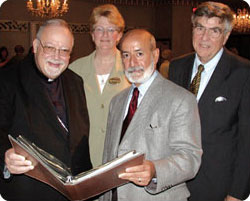Timelines
1979
 The Rev. Dr. John M. Brndjar had a vision.
The Rev. Dr. John M. Brndjar had a vision.
Having attended a seminar by Dr. Elisabeth Kubler Ross, a nationally known advocate for hospice care, he was intrigued by her perspective on discussing the cycle of life and thoughts on how to care for the terminally ill. “She always put the emphasis on life and living, not on death and dying,” says Brndjar, then CEO of Lutheran Welfare Service of Northeastern Pennsylvania, which is now part of Diakon Lutheran Social Ministries.
Embracing her concepts, he spearheaded a mission to offer hospice care in northeastern Pennsylvania, his dream becoming a reality when Hospice Saint John opened in 1979 to serve the needs of both terminally ill patients and their loved ones.
As reportedly the first Lutheran-sponsored hospice in the United States and one of the first such services in Pennsylvania, Hospice Saint John still had to grow from concept to program. “The first thing we needed to do was to get real information. I contacted the first hospice in the U.S. at Yale University in New Haven—the Yale University Hospital System. Many people migrated there to learn the concepts of the program,” says Brndjar.
Knowing the hospice movement had been under way in England for several decades, the LWS board of directors in 1978 sent Brndjar abroad, so that he could visit programs there and bring home what he had learned. He found that programs there used the same approach as in the U.S., serving a person in all of his or her dimensions—physical, spiritual, and social. While they also focused on serving patients’ families, their base of operations was different.
“In England, hospice programs always have a physical location, and a community-based site always is an extension of their main efforts,” says Brndjar. “Ultimately, in the U.S., it was reversed. More and more of the patients suffering from life-threatening diseases wanted to remain in their home environment to receive pain management and palliative care.”
Patients, he adds, “did not want to be isolated from family members and the familiar surroundings of their homes, spending days, weeks, and even months in lonely and impersonal institutional environments, and receiving—all too often—aggressive, painful, and debilitating medical and surgical treatments which were no longer appropriate since they were focused on ‘curing’ and curing was no longer a viable option.”
While program concepts were being developed, funding avenues also were being explored. Grant writer Thomas Cooney secured a three-year $500,000 grant from the Administration on Aging within the U.S. Department of Health, Education, and Welfare’s (now known as Health and Human Services). That assistance came partly because of federal government interest in northeastern Pennsylvania's high concentration of lung cancer diagnoses.
Initially, Hospice Saint John focused its efforts on caring for those with cancer. Over time, however, the program expanded to serve people with a variety of illnesses, including heart and end-stage renal disease, as well as pediatric conditions. In the late 1980s, Hospice Saint John found itself serving individuals affected by the newly discovered disease of HIV/AIDS.
“We had a new commitment to the community. Individuals with HIV and AIDS where returning to [the region] after exhausting all possibilities in metropolitan areas,” says Brndjar. “This was a milestone for the organization. Hospice itself needed to look at its own focus and had to find a comfort and stability in terms of its own capacity to serve individuals with the disease.”
During its initial years, the program also faced the continuing need to educate the medical and general communities about hospice care. The organization also played an essential role in advocating for palliative-care reimbursement by Medicare.
“Simultaneously, we were learning how to provide hospice care, and we were educating people in the medical community as well as the community-at-large that there was a different type of care besides the medical model. Not everyone needed to be treated until the end of their disease and die in a hospital,” says Philip Decker, the program’s first director.
Even more than a quarter-decade after the program’s inception, education is still a continuing need, though reimbursement issues have subsided with the Medicare Act, passed in 1983 partly as the result of the efforts of Decker, his national colleagues, and U.S. legislators.
As a member of a newly formed national hospice organization, Decker traveled to Washington weekly to advocate for reimbursement. Admitting that he sometimes felt overwhelmed, he says he stayed focused on Hospice Saint John’s mission. “If you met with just one patient and family and helped them choose the course of the rest of their life, then you would know what gave us motivation to succeed. It’s a great thing to do.”
Of course, employees have made the organization what it is today, he adds. “Everyone who was there in the beginning did a remarkable job, and Hospice Saint John carries on that tradition as it still has a great reputation today,” says Decker.
Debbie Search, executive director of the Diakon program in 2004, agrees. “All employees—past and present—contribute a great deal. Hospice is part of who they are and not just another job. It is their ministry of service, and they are dedicated to providing care at a very vulnerable time in the life of the patient and their family—with a focus on enhancing their quality of life.”
Though Hospice Saint John has expanded its geographic reach and programs, especially around children’s services and community education, it remains focused on its basic mission: “Hospice care will always be an essential gift,” says Brndjar, “that people can bring to their fellow human beings.”


